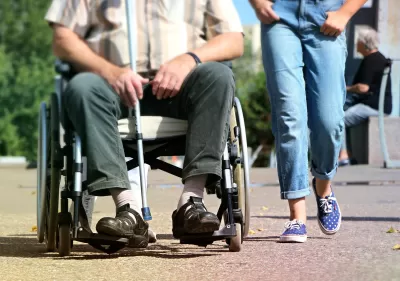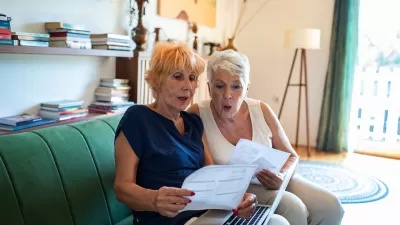A new report highlights inequalities in accessibility and affordability.

Jennifer Molinsky and Whitney Airgood-Obrycki highlight important findings from a recent report from Harvard University's Joint Center for Housing Studies and AARP's Public Policy Institute investigating the role of housing in creating livable neighborhoods. "AARP’s Livability Index is an online resource that provides livability scores for neighborhoods across the US by measuring seven key areas: housing, neighborhood features, transportation, environment, health, engagement, and opportunity."
The report shows that "the places with the highest overall livability scores offer the greatest array of housing options. As one moves up the livability spectrum, the share of multifamily units increases, as does the share of apartments in larger buildings." However, one important finding affirmed the fact that those with higher incomes have access to more livable neighborhoods, as median rents and housing costs are positively correlated with livability. "Improving housing affordability in the most livable communities is critical to ensuring these places are truly open to people of all incomes. While neighborhoods that score highest on the livability spectrum tend to have the most housing types, expanding access to these locations means expanding income-restricted options."
According to the report, older adults are more likely to face cost burdens, making it crucial for government programs to support aging in place and affordable, accessible housing for seniors. "Across all levels of livability, there is need for more accessible housing to meet the needs of the growing number of older adults with mobility difficulties."
FULL STORY: Housing and Livable Neighborhoods

Alabama: Trump Terminates Settlements for Black Communities Harmed By Raw Sewage
Trump deemed the landmark civil rights agreement “illegal DEI and environmental justice policy.”

Study: Maui’s Plan to Convert Vacation Rentals to Long-Term Housing Could Cause Nearly $1 Billion Economic Loss
The plan would reduce visitor accommodation by 25% resulting in 1,900 jobs lost.

Planetizen Federal Action Tracker
A weekly monitor of how Trump’s orders and actions are impacting planners and planning in America.

Waymo Gets Permission to Map SF’s Market Street
If allowed to operate on the traffic-restricted street, Waymo’s autonomous taxis would have a leg up over ride-hailing competitors — and counter the city’s efforts to grow bike and pedestrian on the thoroughfare.

Parklet Symposium Highlights the Success of Shared Spaces
Parklets got a boost during the Covid-19 pandemic, when the concept was translated to outdoor dining programs that offered restaurants a lifeline during the shutdown.

Federal Homelessness Agency Places Entire Staff on Leave
The U.S. Interagency Council on Homelessness is the only federal agency dedicated to preventing and ending homelessness.
Urban Design for Planners 1: Software Tools
This six-course series explores essential urban design concepts using open source software and equips planners with the tools they need to participate fully in the urban design process.
Planning for Universal Design
Learn the tools for implementing Universal Design in planning regulations.
Caltrans
Smith Gee Studio
Institute for Housing and Urban Development Studies (IHS)
City of Grandview
Harvard GSD Executive Education
Toledo-Lucas County Plan Commissions
Salt Lake City
NYU Wagner Graduate School of Public Service





























